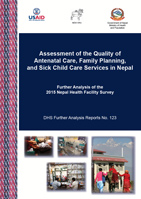There is no printed copy available to order.
Abstract:
In the era of the Sustainable Development Goals, increased access to care alone will not be sufficient to improve health outcomes if health systems cannot provide high quality care. The Nepal Health Sector Strategy 2015-2020 defines health care to be of good quality when it is effective, safe, client-centered, timely, equitable, culturally appropriate, efficient, and reliable. This study assessed the quality of care at health facilities that provide antenatal care, sick child care, and family planning by the eight dimensions using data from the 2015 Nepal Health Facility Survey. We operationalized indicators to measure each dimension and constructed the indicators (except for equity dimension) at the facility level. For the facility level indicators (except the equity dimension analysis), we calculated and compared the mean, median, minimum, and maximum values across all facilities (overall) and by facility characteristics (facility type, managing authority, ecological zone, and provinces). Overall, the facilities performed better in the dimensions of client-centeredness, reliability, appropriateness, and timeliness for all three service areas. The dimensions of efficiency, effectiveness, and safety showed relatively poor performance. Performance was low overall and varied across facilities with important implications for program design. Our analysis found evidence of inequity in the process of care by the client’s age group and education in the antenatal care observations and by the caretakers’ ethnicity and education level for the sick child care services. This study identified potential areas of concern that can be addressed in the design of policies and programs and that can be monitored more closely during implementation of all three service areas.
 Assessment of the Quality of Antenatal Care, Family Planning, and Sick Child Care Services in Nepal (PDF, 2775K)
Assessment of the Quality of Antenatal Care, Family Planning, and Sick Child Care Services in Nepal (PDF, 2775K)
